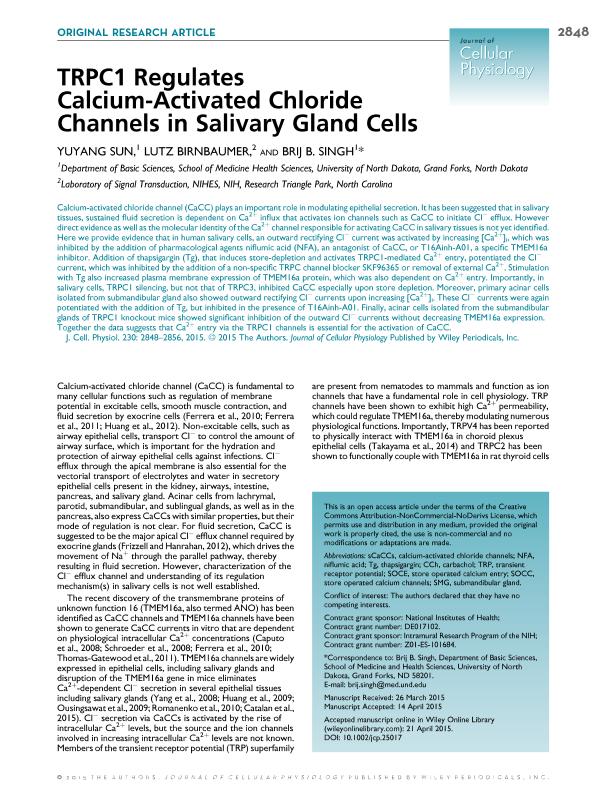Mostrar el registro sencillo del ítem
dc.contributor.author
Sun, Yuyang
dc.contributor.author
Birnbaumer, Lutz

dc.contributor.author
Singh, Brij B.
dc.date.available
2018-03-05T19:27:15Z
dc.date.issued
2015-11
dc.identifier.citation
Sun, Yuyang; Birnbaumer, Lutz; Singh, Brij B.; TRPC1 regulates calcium-activated chloride channels in salivary gland cells; Wiley-liss, Div John Wiley & Sons Inc; Journal of Cellular Physiology; 230; 11; 11-2015; 2848-2856
dc.identifier.issn
0021-9541
dc.identifier.uri
http://hdl.handle.net/11336/37875
dc.description.abstract
Calcium-activated chloride channel (CaCC) plays an important role in modulating epithelial secretion. It has been suggested that in salivary tissues, sustained fluid secretion is dependent on Ca2+ influx that activates ion channels such as CaCC to initiate Cl- efflux. However direct evidence as well as the molecular identity of the Ca2+ channel responsible for activating CaCC in salivary tissues is not yet identified. Here we provide evidence that in human salivary cells, an outward rectifying Cl- current was activated by increasing [Ca2+]i, which was inhibited by the addition of pharmacological agents niflumic acid (NFA), an antagonist of CaCC, or T16Ainh-A01, a specific TMEM16a inhibitor. Addition of thapsigargin (Tg), that induces store-depletion and activates TRPC1-mediated Ca2+ entry, potentiated the Cl- current, which was inhibited by the addition of a non-specific TRPC channel blocker SKF96365 or removal of external Ca2+. Stimulation with Tg also increased plasma membrane expression of TMEM16a protein, which was also dependent on Ca2+ entry. Importantly, in salivary cells, TRPC1 silencing, but not that of TRPC3, inhibited CaCC especially upon store depletion. Moreover, primary acinar cells isolated from submandibular gland also showed outward rectifying Cl- currents upon increasing [Ca2+]i. These Cl- currents were again potentiated with the addition of Tg, but inhibited in the presence of T16Ainh-A01. Finally, acinar cells isolated from the submandibular glands of TRPC1 knockout mice showed significant inhibition of the outward Cl- currents without decreasing TMEM16a expression. Together the data suggests that Ca2+ entry via the TRPC1 channels is essential for the activation of CaCC.
dc.format
application/pdf
dc.language.iso
eng
dc.publisher
Wiley-liss, Div John Wiley & Sons Inc

dc.rights
info:eu-repo/semantics/openAccess
dc.rights.uri
https://creativecommons.org/licenses/by-nc-sa/2.5/ar/
dc.subject
Tmem6a
dc.subject
Trpc1
dc.subject
Salivary Gland
dc.subject
Ca Activated Chloride Channel
dc.subject.classification
Otras Ciencias Biológicas

dc.subject.classification
Ciencias Biológicas

dc.subject.classification
CIENCIAS NATURALES Y EXACTAS

dc.title
TRPC1 regulates calcium-activated chloride channels in salivary gland cells
dc.type
info:eu-repo/semantics/article
dc.type
info:ar-repo/semantics/artículo
dc.type
info:eu-repo/semantics/publishedVersion
dc.date.updated
2018-03-02T17:33:08Z
dc.journal.volume
230
dc.journal.number
11
dc.journal.pagination
2848-2856
dc.journal.pais
Estados Unidos

dc.description.fil
Fil: Sun, Yuyang. University Of North Dakota; Estados Unidos
dc.description.fil
Fil: Birnbaumer, Lutz. National Institutes of Health; Estados Unidos. Consejo Nacional de Investigaciones Científicas y Técnicas; Argentina
dc.description.fil
Fil: Singh, Brij B.. University Of North Dakota; Estados Unidos
dc.journal.title
Journal of Cellular Physiology

dc.relation.alternativeid
info:eu-repo/semantics/altIdentifier/doi/http://dx.doi.org/10.1002/jcp.25017
dc.relation.alternativeid
info:eu-repo/semantics/altIdentifier/url/http://onlinelibrary.wiley.com/doi/10.1002/jcp.25017/abstract
Archivos asociados
